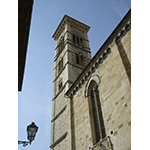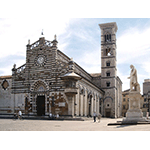Prato Cathedral
The Cathedral of Prato stands on an area that has been a place of worship since time immemorial, and is cited in a document dated 994. It is characterised by its two-colour walls, due to the alternation of alberese limestone and serpentine, and by its powerful, soaring bell tower, begun in the 13th century by master marble worker Guidotto, and completed with the last row of triple lancet windows in 1356. The Cathedral houses several of the most famous masterpieces of art from the 14th to the 15th century, including the world-renowned pulpit by Donatello, the fresco cycles by Agnolo Gaddi, Paolo Uccello, and Filippo Lippi, and the works of sculpture by Giovanni Pisano, and Giuliano, Giovanni and Benedetto da Maiano.
Though mainly important from the historical-artistic viewpoint, the Cathedral also stands out as a place of science: in addition to a vertical sundial in Carrara marble on its right wall, the clock on the facade in place of the usual rose window is also worthy of note. Built around the mid 15th century, this clock had a child puppet that struck the hours, as documented in a text of 1480 that was drawn up on the occasion of its repair. Adjusted and repaired already in the course of the two following centuries, the clock was finally replaced by a new device created in 1795 by Prato clockmaker Domenico Magheri, as testified by a plaque on its frame which reads: «A.M. D.P. Dominicus Magheri Pratensis fecit Anno Domini 1795 – volat ambiguis volubilis alis hora». Magheri’s device is today housed in loco inside a plexiglas showcase. The quadrant surface still presents the 24 sculpted Roman numerals of the fifteenth-century clock, though covered by the 12 Roman numerals in raised bronze. The quadrant inside the Cathedral on the counter facade instead displays the Roman numeration with only 6 figures.
****************************
Texts by Elena Fani
English translation by Victor Beard
Last update 24/gen/2008





